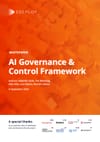⚡ Quick Summary
Deeploy’s whitepaper reframes AI governance from paperwork to practice. It differentiates predictive vs. generative (and hybrid/agentic) risks, open- vs. closed-weight trade-offs, and ties regulations (EU AI Act, GDPR, ISO 42001) to an actionable control stack. The heart of the piece is a seven-category control framework (governance operations, risk management, data governance, transparency, human oversight, operations, lifecycle) with “you’ll know this is working when…” success criteria and evidence artifacts. It also promotes “minimum viable governance,” an AIMS based on ISO 42001, and a use-case pipeline of DPIA/FRIA/AIPA/vendor checks—anchored by visuals like the lifecycle diagram and open/closed comparison.
🧩 What’s Covered
- The AI landscape: Clear split between predictive “forecasters” and generative “creative conversationalists,” with distinct governance emphases (accuracy/fairness vs. content/behavior). Real-world failure modes are illustrated (Dutch child-benefit scandal; deception risks in frontier models). (pp.4–7)
- Open- vs. closed-weight models: A balanced matrix of privacy, cyber, bias/liability, misuse, and market-power risks (see the comparison table on p.8). It highlights regulatory role implications (provider vs. deployer) and the “hybrid future” most firms will face.
- Lifecycle integration: A concise ideation → build → operate diagram (p.9) showing where to catch risk early and cheaper; stage-specific risks and mitigations follow (pp.10–11).
- Regulatory mapping: A digest of the EU AI Act (risk tiers, roles, obligations), with touchpoints to GDPR (lawful basis, ADM, data rights), plus DSA/DMA/DORA and ISO 42001 as the management backbone. Roles (provider/deployer/distributor) are clarified (pp.12–16).
- Implementation: How to stand up an AIMS: ownership across 3 lines, an AI use policy, risk process, model/data documentation, and incident response—then scale beyond “compliance theater.” The Robodebt case is used to stress practice over paperwork (pp.18–19).
- Control framework (core value): Seven categories with concrete controls and auditable evidence:
- Governance operations (policies, roles, AI literacy) (p.22)
- Risk management (registry, assessments, classification, RMS) (p.23)
- Data governance (process, cards, bias testing) (p.24)
- Transparency (capabilities/limits, explainability, instructions, impact assessment) (p.25)
- Human oversight (monitoring, intervention, competence, redress) (p.26)
- Operations (logging, accuracy/robustness, security) (p.27)
- Lifecycle (versioning, sign-off, technical docs) and CE marking steps (pp.28–29).
- Voices from partners & next steps: Emphasis on trust, proportional rollout, and third-party validation/certification. (pp.30–33)
💡 Why it matters?
This is a rare, operational bridge between law and engineering. It shows exactly what to implement, what evidence to retain, and how to know controls are working—crucial for high-risk systems under the EU AI Act. By anchoring governance in lifecycle and MLOps (logging, drift, rollback, sign-offs), it reduces rework, speeds approvals, and strengthens procurement readiness. The open/closed model matrix and role clarification help avoid hidden “provider” obligations. In short: fewer blind spots, faster delivery, and defensible compliance.
❓ What’s Missing
- Deeper genAI/agent controls: Stronger coverage of jailbreak defense, content provenance (C2PA), watermarking, and eval harnesses for LLM behavior.
- Metrics & thresholds: Practical benchmark ranges (e.g., bias/accuracy drift triggers) and reference KPIs per risk tier.
- Templates/examples: Redacted exemplars of data cards, FRIA/AIPA, and sign-off checklists to accelerate adoption.
- Vendor SLM specifics: More detail on shared-responsibility matrices for closed-weight APIs and audit rights.
- Cross-standard mapping: A table aligning the seven control areas to ISO 42001 clauses and AI Act annexes.
👥 Best For
- Chief Risk/Compliance/Privacy Officers operationalizing EU AI Act readiness.
- ML/AI Leads & Platform teams building governance into MLOps.
- Product Owners of high-risk use cases (hiring, credit, essential services).
- Procurement & Vendor Managers negotiating AI assurances with providers.
📄 Source Details
- Title: AI Governance & Control Framework
- Authors: Maarten Stolk, Tim Kleinloog, Ellen Mik, Lara Zijlstra, Romain Vadon
- Publisher: Deeploy • Date: 9 Sep 2025 • Length: 33 pp.
- Notable visuals: Open/closed model risk matrix (p.8); AI lifecycle diagram (p.9); seven-category control tables with evidence and success criteria (pp.22–29).
📝 Thanks to
Acknowledges co-development and contributions from partners (e.g., Deloitte, Nemko, Datashift, Carve, Clever Republic, Conclusion AI 360, BearingPoint, Considerati), with contact points listed on p.33.


